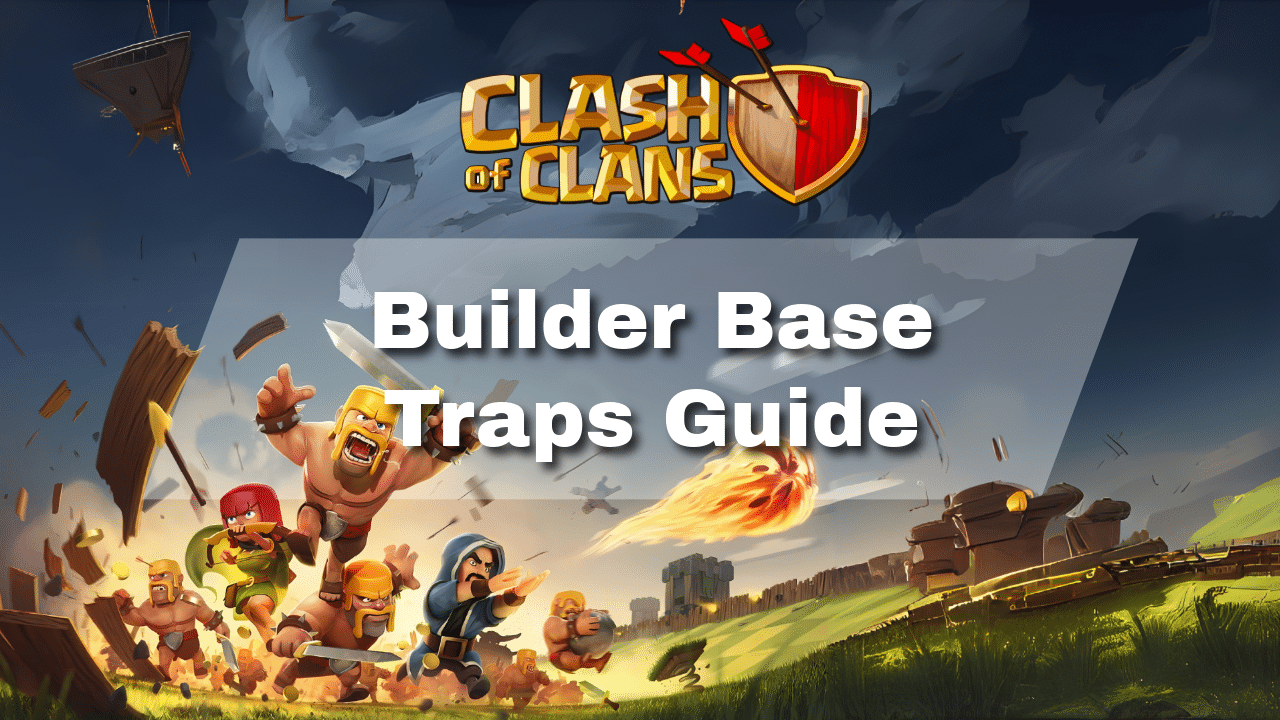Clash Of Clans Builder Base Traps Guide - Theria Games

Introduction to Clash of Clans Builder Base Traps
Clash of Clans Builder Base Traps are relatively inexpensive defensive structures that remain hidden until activated by enemy troops moving within their trigger radius. When used correctly, traps can significantly enhance your village’s defense. These traps are not like other buildings because they do not light up the map and remain concealed until triggered. They are always ready for the next battle and do not require re-arming, unlike traps in the Home Village.
Push Trap
The Push Trap in the Builder Base pushes ground units through the air within its capacity, with no effect on air units. This trap does not deal damage but uses spring weights to determine how many ground units can be affected. The Push Trap has a variety of spring weights based on the type of troop:
Skeletons (from Drop Ships) have a spring weight of 1.
Sneaky Archers have a spring weight of 3.
Raged Barbarians have a spring weight of 4.
Bombers and Hog Riders have a spring weight of 12.
Night Witches and Electrofire Wizards have a spring weight of 14.
Cannon Carts have a spring weight of 16.
Boxer Giants have a spring weight of 18.
Power P.E.K.K.As have a spring weight of 22.
The Battle Machine has a spring weight of 25 but cannot be affected by this trap.
The Push Trap does not need to be re-armed and can be upgraded with the help of the Master Builder or O.T.T.O.
Offensive Strategies
When facing the Push Trap, it’s best to use an expendable unit, such as a Raged Barbarian, to trigger the trap. This allows you to activate the trap without risking valuable troops. The Push Trap remains hidden until triggered, so you will need to predict where it is placed within the base.
One effective strategy is to use the Battle Machine to trigger Push Traps and other traps. Since the Battle Machine is unaffected by the Push Trap, it can safely trigger them without being launched into the air. This can help identify trap locations and ensure your other troops can navigate the base without disruption.
The effect of the Push Trap on Sneaky Archers varies depending on the direction they are pushed. If they are pushed farther away from their target, their time to attack while invisible is reduced, or they may retarget altogether. On the other hand, if the Push Trap pushes them closer to their target, it may not benefit the defense much, as the Sneaky Archer can still attack from the new position. However, this effect can be negated if the Push Trap is followed up by another trap, such as a Spring Trap, as it could cause the Sneaky Archer to be eliminated before they can continue attacking.
Defensive Strategies
The Push Trap can be strategically used to push enemy troops away from critical buildings, such as the Builder Hall or key defenses. By pushing units into hazardous areas, you can make the most of the trap’s effect. For example, pushing troops into a Spring Trap, Mega Mine, or high-damage buildings like the Crusher can inflict more damage or even eliminate enemy units, making the Push Trap an effective tool for weakening or stalling an attack.
Additionally, you can use the Push Trap to push units into a space surrounded by Walls, effectively trapping them and preventing them from advancing further. This tactic can help isolate enemy troops and buy time for other defenses to deal with them.
Another interesting strategy involves placing Push Traps in a way that pushes enemies into additional Push Traps. This technique works particularly well with high-value troops, such as Boxer Giants, as it can stall and disrupt an attack. However, this strategy requires multiple Push Traps, which may not always be the most efficient use of resources.
Alternatively, you can upgrade a few Push Traps to higher levels and position them strategically to push enemy units onto a lower-level Push Trap. A higher-level Push Trap can affect more troops, splitting up the opponent’s units and potentially making it harder for them to coordinate their attack effectively.
It’s important to be cautious about placing Push Traps near Mega Mines, as the trap could accidentally push enemy units out of the blast radius, rendering the mine ineffective. Additionally, positioning Push Traps around the edge of a short-range defense’s radius can be particularly effective against Cannon Carts. By pushing a Cannon Cart closer to the defense, you negate its range advantage, preventing it from sniping defenses in Mortar Mode. However, because Cannon Carts have a spring weight of 16, this tactic only works if the Push Trap is upgraded to at least level 5 or higher.
Spring Trap
The Spring Trap is defensive in the Builder Base designed to launch ground troops off the map. When triggered, affected units appear to fly out of the map, effectively removing them from the battle. This makes the Spring Trap a valuable tool for disrupting enemy troop formations and potentially eliminating key units.
The Spring Trap does not require the Master Builder or O.T.T.O for construction, but these are necessary for upgrading the trap. The Spring Trap’s effectiveness depends on its spring capacity, which determines how many troops it can launch at once. As the trap is upgraded, its spring capacity increases, allowing it to spring more troops at a time.
Each troop has a specific spring weight that determines how many units can be launched. For example, Skeletons spawned by
Drop Ships have a spring weight of 1.
Raged Barbarians have a spring weight of 4.
However, all other ground units have a spring weight greater than 8, which exceeds the capacity of the highest-level Spring Trap, making them immune to being launched by this trap. This means the Spring Trap is most effective against lighter, smaller troops and may not be as useful against larger, heavier units.
Offensive Strategies
The Spring Trap can be strategically placed to target troops commonly used for tanking or cleaning up after other units, such as Barbarians, Archers, and smaller troops. It is particularly effective in eliminating these lighter units, as it can completely remove them from the battlefield by launching them off the map. This makes it a valuable tool for disrupting enemy cleanup strategies or preventing tanking units from protecting more valuable troops.
However, the Spring Trap may not be as effective against larger units like Giants or Golems. These heavier units have a spring weight that exceeds the capacity of even the highest-level Spring Trap, meaning they are immune to being launched off the map. When planning your defense, consider positioning Spring Traps in areas where smaller, faster troops are likely to pass through, maximizing their potential to disrupt enemy strategies.
Defensive Strategies
Defensively, Spring Traps should be positioned near structures that typically attract large groups of weaker troops, such as resource storages or splash-damaging defenses like the Roaster or Crusher. These areas often draw multiple low-weight units, making them prime spots for maximizing the Spring Trap’s effectiveness.
Narrow passages or choke points are also excellent locations for Spring Traps. Troops tend to bunch together when funneled through tight spaces, increasing the likelihood of multiple units being launched off the map simultaneously. Careful placement of Spring Traps in these areas can disrupt an opponent’s attack strategy and eliminate critical cleanup or tanking units early in the battle.
Mine
Mines are splash-damaging traps in the Builder Base that target either ground or air troops, depending on their configuration. They deliver low damage over a relatively large area and also push troops back upon detonation. Unlike the Bomb, Mines have a faster activation time of just one second, making them more effective for quick responses to advancing troops.
Mines are versatile due to their ability to switch between targeting ground or air troops, but they cannot target both simultaneously. While their damage output is low, they shine in numbers and are effective at eliminating swarms of low-hitpoint units or disrupting support troops.
When triggered, a Mine explodes after detecting an enemy within a 4-tile radius, dealing splash damage to all enemy troops within a 5-tile area. This delayed activation makes them most effective when placed near buildings where troops are likely to linger, such as defensive structures or key objectives.
Like other traps in the Builder Base, Mines do not require re-arming after triggering. They can be constructed without the Master Builder or O.T.T.O, but these are necessary for upgrades, allowing Mines to improve their damage and effectiveness over time.
Offensive Strategies
Mines are less effective against high-hitpoint troops like Baby Dragons or the Battle Machine due to their relatively low damage. These troops can absorb the blast without being significantly impacted, making them ideal for triggering Mines with minimal risk.
When using Bombers to break Walls, always test for nearby Mines by sending in an expendable troop like a Raged Barbarian. This ensures the Bomber can safely complete its task without being taken out prematurely by a Mine.
To minimize the impact of Mines on low-hitpoint troops, stagger their deployment instead of sending them all at once. This reduces the risk of multiple troops being hit by a single explosion, allowing your forces to remain effective during the attack. Proper spacing and timing can make a significant difference in countering Mines effectively.
Defensive Strategies
Mines can be strategically placed on the outer edges of your base to damage or eliminate sneaky attackers like Sneaky Archers. By anticipating common sniping locations, you can use Mines to disrupt their attacks effectively.
Positioning two Mines together can eliminate Sneaky Archers and Beta Minions of similar levels, while three Mines can take out Raged Barbarians. However, grouping Mines this way consumes a significant portion of your resources and is generally not advisable unless the situation calls for it.
Switching Mines between Ground and Air modes depends on your defense needs. If ground attacks are causing frequent losses, set Mines to Ground mode. If air attacks are the issue, set them to Air mode. A balanced approach with Mines split between both modes can help against mixed strategies.
Place a Mine near expected Bomber entry points to disrupt them before they throw their first bomb, allowing defenses to eliminate them quickly.
To counter air swarms, use Mines set to Air mode around Firecrackers. This combination effectively counters Beta Minions. Air Mines can also be placed near Builder Halls in corners, particularly when supported by a Roaster or Air Bombs, to disrupt air troop strategies and protect critical structures.
Against Night Witches, a single Air Mine can stop a swarm of Bats. Similarly, Ground Mines can counter Skeletons spawned by Drop Ships if triggered by other ground units, such as the Battle Machine. This can prevent overwhelming numbers from advancing deeper into your base.
Mega Mine
The Mega Mine is a powerful trap unlocked at Builder Hall level 4 in the Builder Base. It operates similarly to the Giant Bomb in the Home Village but with additional versatility. The Mega Mine can be configured to target either ground or air troops, making it adaptable to various attack strategies.
Visually, the Mega Mine resembles a larger version of a regular Mine, with two chains anchoring it to the ground when set to air mode. Its explosion delivers significant damage over a wide radius, capable of eliminating smaller units like Raged Barbarians or Beta Minions outright, depending on its configuration.
While larger units like Boxer Giants, Hog Gliders, or Baby Dragons may survive the blast, the Mega Mine can severely weaken them, leaving them vulnerable to follow-up defenses. Proper placement and mode selection allow the Mega Mine to be a critical component in thwarting enemy attacks.
Offensive Strategies
When facing a Mega Mine, it’s important to plan carefully to minimize its impact on your attack. Use an expendable unit or a high-hitpoint troop to trigger the trap before sending in more valuable units. The Battle Machine is particularly useful for this, as its ability can regenerate health lost from the Mega Mine’s explosion.
You can activate a Mega Mine over Walls by deploying a troop within its trigger radius. This strategy is especially effective against bases with Mega Mines hidden within their core defenses.
Keep in mind that the Mega Mine’s damage radius is larger than its trigger radius, meaning troops farther away from the triggering unit can still be affected. Be cautious with troop placement to avoid unnecessary losses.
Look for empty 2×2 spaces in your opponent’s base layout, as these are likely spots for hidden Mega Mines or Hidden Teslas. Identifying and avoiding these traps can significantly improve your attack’s effectiveness.
Defensive Strategies
The Mega Mine’s high damage makes it most effective when placed inside the base, targeting tanky units like Boxer Giants or Hog Gliders. Avoid placing it on the outskirts, where it might be triggered by weaker units, wasting its potential.
Setting the Mega Mine to air mode is a great way to deal with Baby Dragons or swarms of Beta Minions. It can effectively protect defenses like Firecrackers and Air Bombs, crippling enemy air attacks before they gain momentum.
Against Night Witches, Mega Mines can deal devastating damage or even outright eliminate them, especially if the Mega Mine is at least half the level of the Night Witches. A clever but risky strategy is to place a Mega Mine in a corner where attackers might deploy Night Witches to stack Bats. If untriggered by the attacker’s Battle Machine or other units, this can ruin their attack entirely.
In trophy ranges dominated by Night Witch strategies, setting the Mega Mine to ground mode can be a strategic advantage. Simultaneously, you can configure regular Mines to air mode to protect against Bats, creating a balanced trap setup that counters multiple attack types effectively.
General Placement Tips for Traps
Summary
The placement of traps is crucial to their effectiveness. Poorly placed traps can be wasted, while well-placed ones can significantly impact the outcome of a battle. The key is to predict the paths enemy troops are likely to take and place traps in areas where they will cause the most disruption or damage.
Strategies for Placement
Near Key Structures:
🔹Place traps near high-value targets such as the Builder Hall, defensive buildings, or key resource storages. This ensures that they trigger when the enemy is focused on critical objectives.
Choke Points:
🔹Set traps in narrow paths where troops are likely to bunch up, maximizing the damage or disruption they can cause. Mines and Mega Mines are particularly effective in these spots.
Unexpected Locations:
🔹For traps like the Spring Trap or Push Trap, place them in less obvious areas to catch attackers off guard. This can disrupt their attack plans and force troops into less favorable areas.
Complement Other Defenses:
🔹Combine traps with splash-damage defenses like the Multi Mortar or Crusher to maximize their effectiveness. For example, use a Push Trap to shove troops into the Crusher’s radius or a Mega Mine to soften a group before they reach a key defense.
Air vs. Ground Settings:
🔹Adjust the Mine and Mega Mine based on the attack strategies you face most often. If you encounter frequent air raids, set these traps to target air troops to provide extra coverage.
❓What types of traps are available in Builder Base 2.0 and what do they do?
In Builder Base 2.0, you have access to various traps, including the Push Trap, Spring Trap, Mega Mine, Mine, and Air Bomb. Each serves a different purpose:
🔹Push Trap flings troops in a set direction.
🔹Spring Trap ejects ground units off the battlefield instantly.
🔹Mega Mine deals massive area damage, especially effective against groups.
🔹Mine is a smaller version of the Mega Mine, useful for early troop waves.
❓How should traps be placed for maximum effectiveness in Builder Base?
Traps work best when used strategically near chokepoints, defenses, or pathing zones. Push Traps can redirect troops into Crushers or off-path areas. Spring Traps are best along narrow pathways. Mega Mines and Mines should be placed where groups of troops are likely to bunch up—like near the Builder Hall or behind walls. Air Bombs work well near air-targeting defenses to soften air troops before they reach core buildings.
❓Do Builder Base traps deal splash damage or only affect single targets?
Some traps deal splash damage, while others affect single units:
🔹Mega Mine, Mine, and Air Bomb deal area damage, effective against groups.
🔹Spring Trap affects only a few units (based on troop housing space), ejecting them instantly.
🔹Push Trap affects single or few troops by repositioning them without damage.
❓Can you upgrade traps in Builder Base 2.0 and is it worth doing?
Yes, traps can be upgraded, and upgrading is very worthwhile. Higher levels increase the damage of Mines, Mega Mines, and Air Bombs, while Spring Traps can eject stronger troops, and Push Traps can fling units farther. Well-leveled traps can disrupt attacks and eliminate key troops early, especially in tight or well-funneled base layouts.
❓How do you counter Builder Base traps during an attack?
To counter traps, use scouting strategies like sending one or two low-cost troops first to trigger them. Troops like Sneaky Archers or Beta Minions can safely bait Push Traps and Mines. Avoid clumping units too closely to reduce splash damage from Mega Mines and Air Bombs. Also, learn common trap placements from frequently seen base layouts to adapt your troop deployment.













